Meet the new Royal baby: Symphony of the Seas
Royal Caribbean’s newest ship is also the largest in the world. By developing a new app and focusing on a data-centric approach, the company is edging closer towards its goal of providing a “frictionless” experience, as Frances Marcellin finds out
f Royal Caribbean’s Symphony of the Seas were to stand upright, at 1,188ft long it would be taller than the Eiffel Tower. Weighing 228,081 gross registered tons (GRT), the newest member of Royal Caribbean’s 25-strong fleet can support 6,680 guests and is officially the biggest cruise ship in the world.
Yet Richard Fain, CEO and chairman of Royal Caribbean, says that building the biggest ship in the world wasn’t the initial intention.
“We set out to build the best ship in the world, and it turned out it was the biggest,” he says. “As we said from the beginning, this class of ship resonated with the guests, so we’ve kept building and refining it. I hope when you’re on board you don’t think of it as a big ship, but ‘I’ve got lots of choices’.”
Suite view of the sea. Royal Caribbean is actually the biggest – yet one of the most understated – luxury accommodation providers in the cruise market.
Credit: Royal Caribbean, SBW-Photo
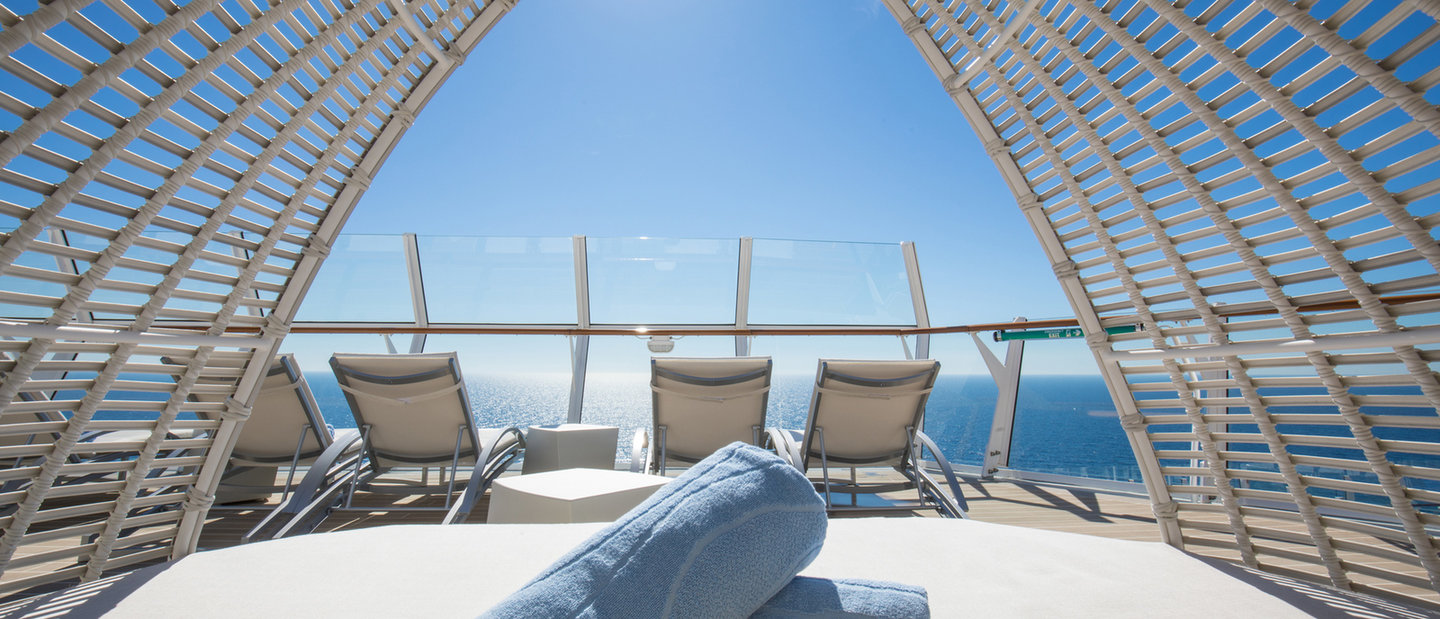
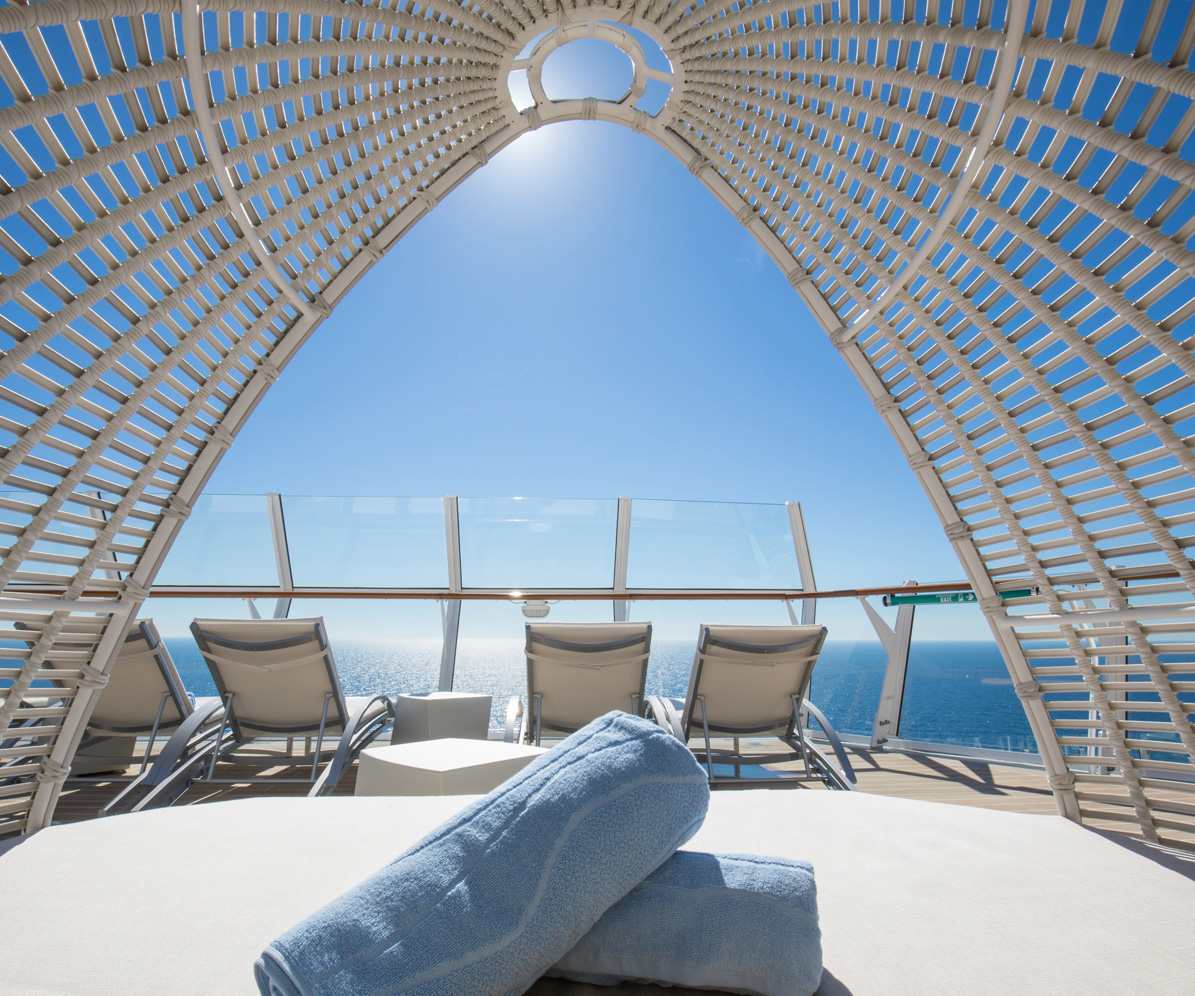
Samsung-designed smart bracelets connect to the MSC for Me system. Image courtesy of MSC Cruises
Sailing towards a frictionless passenger experience
Fain explains that the overall goal for Symphony of the Seas has been to design the ultimate vacation experience at sea. “Beyond that we’re trying to create the ultimate vacation,” he says. “Define and develop experiences and build something that’s more akin to
a city.”
With seven vastly different neighbourhoods – including the rambunctious Boardwalk with its carousel and café terraces, as well as the rather-more-quiet Central Park, which, with its tropical foliage and elegant eateries, feels like the old quarter of a European town – the ship is indeed a floating city.
“The overall goal for Symphony of the Seas has been to design the ultimate vacation experience at sea”
There are plenty of choices to consider on board, including: a ten-deck-high dry slide; water parks; 24 swimming pools; an inconceivably large and luxurious gym and spa; surf simulators; zip line; ice rink; laser quest; a plethora of high-level entertainment shows (which hire Olympic ice skaters and Red Bull Cliff Diving World champions); and 22 distinctive restaurants.
But with such a concentration of people over 16 decks (up to almost 9,000 including staff) – all who want to embark and disembark as quickly as possible – it’s easy to understand why queue elimination and a “frictionless passenger experience” have become central to Royal Caribbean’s vision.
Cabin onboard the MSC Seaside
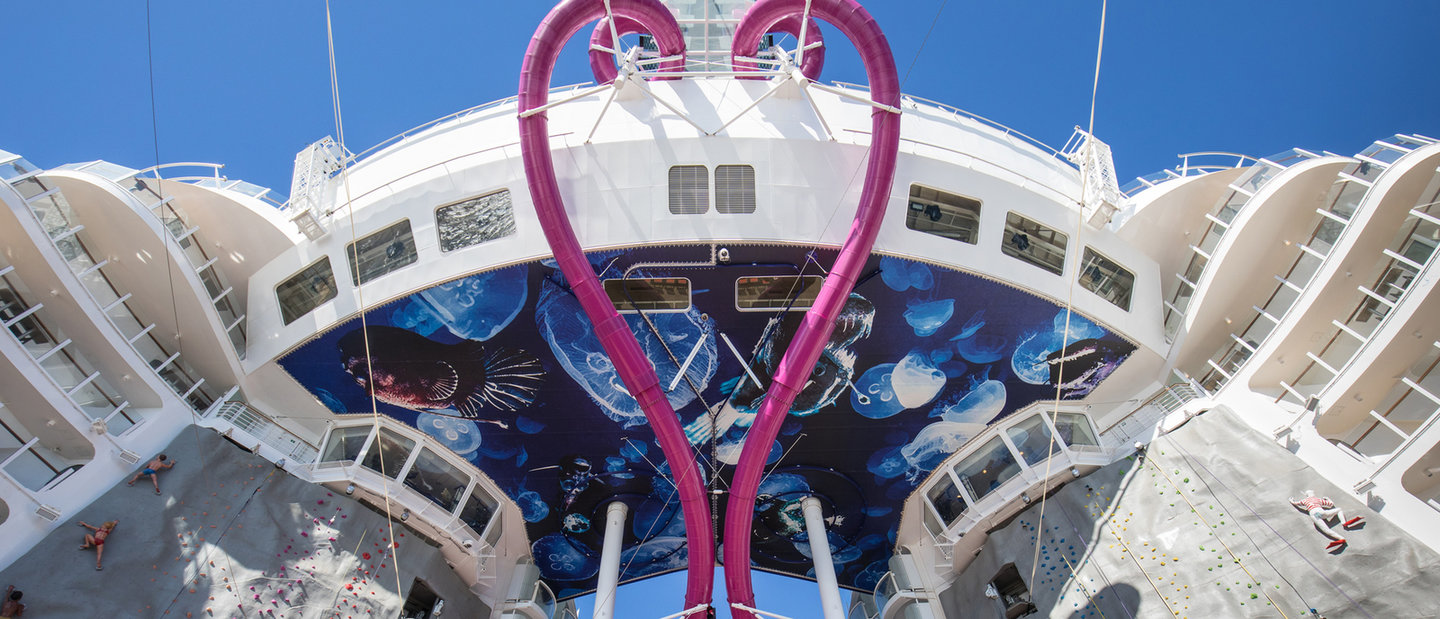
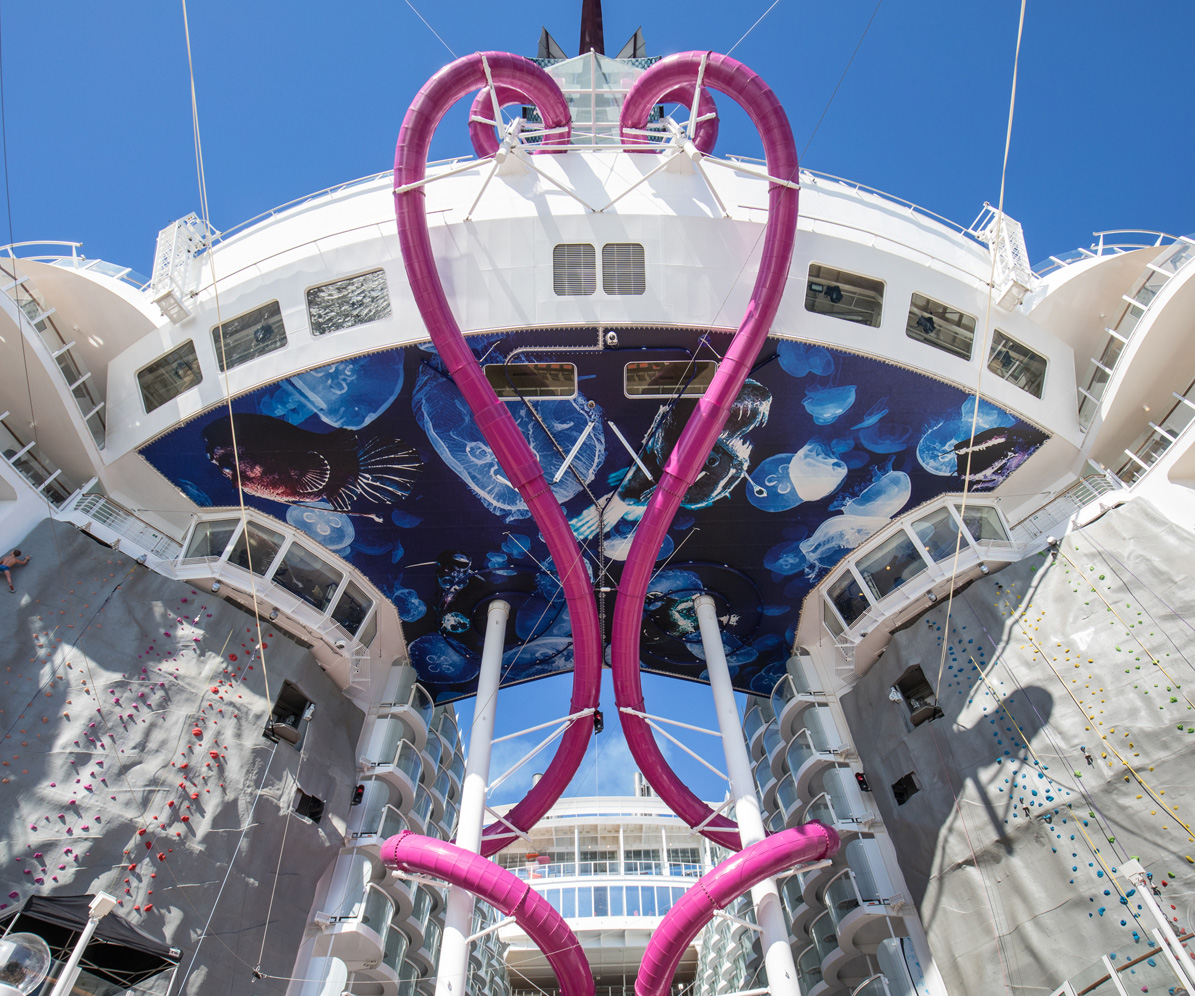
A digital and data-centric approach
A digital and data-centric strategy is the driving force behind the company’s frictionless travel goal. Sol Rashidi joined the team as chief data and cognitive office in April last year, about six months after senior vice president of digital, Jay Schneider, who came across from Disney having introduced the cruise line’s Magic Bands and mobile app.
“The company has always been data-centric, we measure everything,” says Schneider. “The cognitive side of it is that there continues to be a merging technology that makes the understanding of the data about our consumers, our ships and our business better,” he continues. “It really is a recognition of trying to look at all the data that we have by new technology and to find insights.”
“One of the things they’re building now for an Autumn 2018 launch is a simple, virtual digital concierge”
Transforming the huge volume of data the vacation company has into quality data is the first part of the process, then there’s its unification. Schneider says it’s about getting the nugget of information from the passenger to the end point on board. “Let’s say you told the travel agent you have a dietary preference – how do we get that to every server and every waiter on board?”
Schneider says it’s easier to focus on the unification side than the quality side, which is tougher. “We’re probably 25% of where we want to be on our quality side,” he says, “whereas unification, we’re 75%-80% of the way.”
Across all the units the digital team is trying to figure out how they can apply any combination of machine learning and natural language processing. Schneider says that one of the things they’re building now for an Autumn 2018 launch is a simple, virtual digital concierge that allows consumers to type in any question that they have and get a response.
“There will be a voice mechanism if people will use it,” he says, adding that during consumer testing guests preferred typing.
The new Royal app is currently available on five ships. Credit: Royal Caribbean
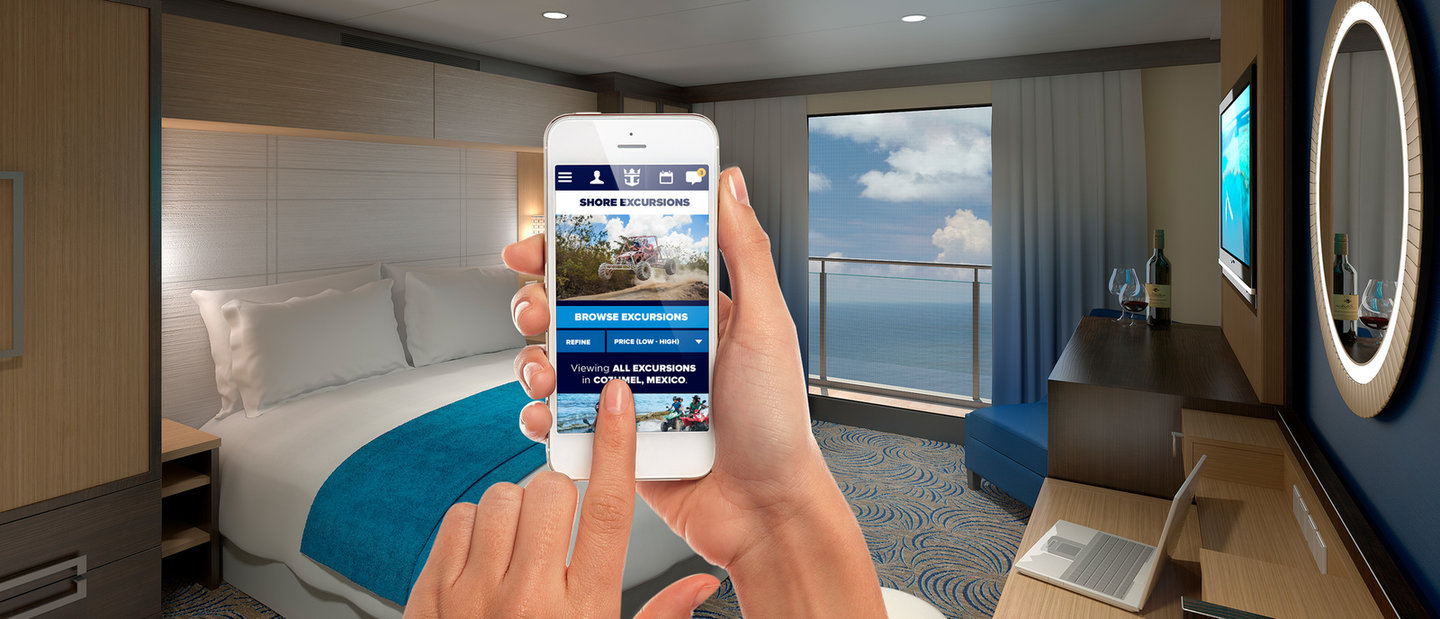

New Royal app rolled out across the fleet
What is available now on Symphony – and four other ships across the fleet (Allure, Enchantment, Oasis and Serenade) – is the new Royal app, which has succeeded the previous one, Royal iQ (now only available on four ships). Capabilities vary depending on the ship, but the app and new features are to be rolled out across the fleet throughout 2018.
The app works on the ship’s WiFi from anywhere, so guests don’t have to buy Internet access to use it, and it can also be used from their home, before and after the cruise. This way guests can plan their trip in advance.
“The app works on the ship’s WiFi from anywhere, so guests don’t have to buy internet access to use it"
Guests who want to connect on board to do other Internet-related activities, from networking on Twitter to streaming Netflix, will need to buy one of the ‘Voom’ packages. Powered via satellite-enabled connectivity solutions from SES Networks, the company’s satellite provides speeds of up to 1Gbps on board.
To build the app, Royal Caribbean’s internal digital team worked with two key technology partners, Globant, which specialises in personalised digital journeys for users, and UX and design company Fantasy Interactive.
The design strategy is focused entirely around removing friction from the passenger experience. As the vessel’s paper Cruise Compass – the daily activity and guide – is a passenger’s most treasured tool on board, the first stage was to include all this related rich content into the app.
The next step was to make restaurant menus available as well as provide deck maps and shore excursion details – any element of the cruise where passengers would have to queue. Booking and cancelling activities “without having to get off your chair” was next.


The new Royal app contains rich content about all the venues and activities on board, replacing the paper Cruise Compass if passengers desire. Credit: Frances Marcellin
The new app’s design strategy is focused entirely around removing friction from the passenger experience. Credit: Royal Caribbean
Speedy check-in goals with Expedited Arrival
As embarkation can be one of the most stressful parts of the cruise, a new Expedited Arrival procedure was tested on Allure of the Seas before launching on Symphony of the Seas. Tests on Allure showed seven minutes “from car to bar”, but expedited boarding times on Symphony can take up to 15 minutes.
To register for Expedited Arrival, guests need to enter information online prior to sailing, take a selfie with their phone and scan their passport to receive a digital Set Sail pass. Then they can bypass the traditional check-in procedure at the terminal and the written questionnaire that is mandatory before sailing. This is carried out by an Expedited Arrival steward, which was recorded at one minute and 47 seconds.
"Other improvements and developments will work their way into the app, including real-time blue-dot wayfinding”
Little by little other improvements and developments will work their way into the app, including real-time blue-dot wayfinding, 3D deck maps, videos of activities, free messaging, and folios tracking payments.
One of the biggest future additions will be the virtual concierge, which will make proactive recommendations based on passenger preferences.
And while radio-frequency identification (RFID) WOWbands, which allow guests to pay for goods and enter staterooms (like the Sea Pass card), are still available, in the future geo-location wrist bands will be developed to help parents track kids, and so staff can locate the passenger for more flexible services.
Tech to attract more millennials on board
Cruise Lines International Association’s latest industry report shows that demand for cruising has increased by 20.5% in the last five years and Royal Caribbean’s new app also forms part of the strategy to entice the millennial generation on board.
Recent study results from Pew Research Centre show that 92% of millennials own a smartphone and spend an average of 223 minutes per day on it. They are also having families, with 1.2 million millennial women accounting for 82% of US births in 2016.
The app is considered by Ben Bouldin, Royal Caribbean’s associate vice president and managing director for the UK & Ireland, as being a key factor to attracting more millennials on board.
"Families looking for a luxurious two-bed room that will also keep the children entertained can book the new Family Suite”
“We have to be more appealing to millennials as they’re now parents, and families are what we’re all about,” says Bouldin. “We’ve got to make sure we’re relevant to them.”
Families looking for a luxurious two-bed room that will also keep the children entertained can book the new Family Suite on deck 17. It spans two levels, 1,346ft2 and includes a private cinema, Lego wall and table tennis. Prices start at £30,000 a week for a family of four, and it is fully booked for the rest of 2018.
“We never position ourselves as a high-end operator, but high-end doesn’t mean you don’t want to have fun,” says Bouldin.
Suite success – focusing on the luxury market
The luxury market is another area that Bouldin wants to put more focus on. “We’ve got many different suites on this ship that we should make more of,” he says, adding that Royal Caribbean is actually the biggest – yet one of the most understated – luxury accommodation providers in the cruise market.
“We’ve got 38 suites a week across Independence and Navigator, that’s just on two ships. Think about Oasis and Quantum class, the numbers are enormous.”
Suite features vary depending on size, but Royal Loft Suites include a baby grand piano (Oasis class only), private bar, library, an extended balcony and a hot tub. Passengers can also take advantage of the Royal Genie, who tailor-make experiences for guests, both on demand and spontaneously.
"The hardest part of growing the market is battling against the misconceptions people have about cruise ships”
“If they know a kid loves football then they’ll organise a football tournament one day,” says Bouldin. “It’s that kind of service, they try to understand guests’ needs.”
Bouldin says that the hardest part of growing the market is battling against the misconceptions people have about cruise ships. “It’s so heavily engrained,” he says. “I’ve got friends and family that have this belief, but when you see it, you believe it – it’s unimaginable how extraordinary this is.”
He points out that Royal Caribbean’s strapline is “where extraordinary happens”. “Coming on to this ship has made me believe that the tagline actually has some longevity,” he says. “This is where extraordinary happens – all over the place, all of the time.”